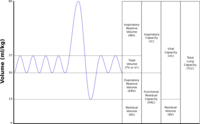
Photo from wikipedia
Multiple breath nitrogen washout (MBNW) indices provide insight into ventilation heterogeneity globally [lung clearance index (LCI)] and within acinar (Sacin) and conducting (Scond) airways. Normal aging leads to an accelerated… Click to show full abstract
Multiple breath nitrogen washout (MBNW) indices provide insight into ventilation heterogeneity globally [lung clearance index (LCI)] and within acinar (Sacin) and conducting (Scond) airways. Normal aging leads to an accelerated deterioration of Sacin in older adults, but little is known about the contribution of peripheral airway function to changes in pulmonary function indices reflecting expiratory airflow [forced expiratory volume in one second (FEV1)/forced vital capacity (FVC)] and gas trapping [residual volume (RV)/total lung capacity (TLC)] with aging. We aimed to examine associations between MBNW and FEV1/FVC as well as RV/TLC in healthy adults, and to determine if these relationships differ in older (≥50 yr) versus younger subjects (<50 yr). Seventy-nine healthy adult volunteers aged 23-89 yr with no cardiac or respiratory disease and a smoking history of <5 pack-years underwent spirometry, plethysmography, and MBNW. After adjustment for sex, height, and body mass index, the following relationships were present across the entire cohort: Sacin was inversely related to FEV1/FVC (R2 = 0.22, P < 0.001); Sacin and Scond were positively related to RV/TLC (R2 = 0.53, P < 0.001); on separate analyses, the relationship between Sacin and FEV1/FVC was strongest in the older group (R2 = 0.20, P = 0.003) but markedly weaker in the younger group (R2 = 0.09, P = 0.04); and Sacin and Scond were related to RV/TLC in older (R2 = 0.20, P = 0.003) but not younger subgroups. No relationships were observed between LCI and FEV1/FVC or RV/TLC. Changes in FEV1/FVC and RV/TLC are at least in part due to changes in peripheral airway function with aging. Further studies of the relationships between MBNW and standard pulmonary function indices may prove useful for their combined application and interpretation in obstructive airways disease. NEW & NOTEWORTHY This study explores associations between multiple breath nitrogen washout (MBNW) and standard pulmonary function indices reflecting expiratory airflow [forced expiratory volume in one second (FEV1)/forced vital capacity (FVC)] and gas trapping [residual volume (RV)/total lung capacity (TLC)] in healthy adults across a wide range of ages. We have demonstrated statistically significant relationships between MBNW and FEV1/FVC as well as RV/TLC. These findings provide novel evidence of the contribution of peripheral airway function to changes in standard pulmonary function indices with aging.
Journal Title: Journal of applied physiology
Year Published: 2018
Link to full text (if available)
Share on Social Media: Sign Up to like & get
recommendations!